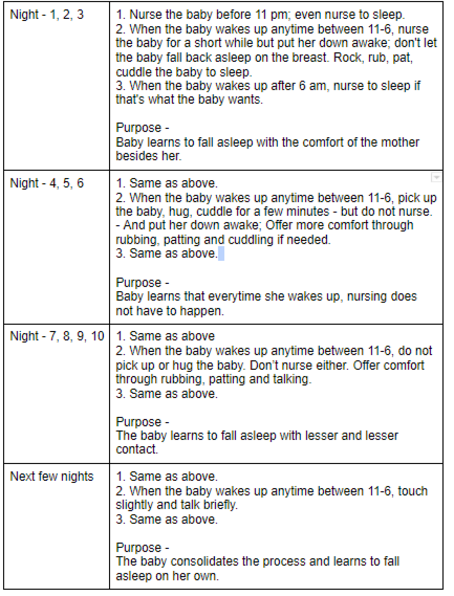Why does my baby not sleep at night?
WHO recommends that a baby must be breastfed for a minimum of 2 years and beyond.
Partial weaning can be a very important step in the journey to weaning the baby off the breast. In some cases, it might serve as an alternative to complete weaning as partial weaning too can provide a lot of relief to mothers who are struggling to cope with breastfeeding beyond 2 or more years. It is important to note that partial weaning should be introduced no sooner than 18 months.
Types of Partial Weaning :
- Day time weaning
- Nighttime weaning
Some mothers choose to either day-wean or night-wean their baby depending on which feels more overwhelming for them. It’s a completely subjective decision with no type of weaning being better or easier. The decision can be made based on what would work best for the baby, the mother and the family. Both types have some common and some specific techniques, which are discussed below.
1) Day Time Weaning Techniques
Starting with the ‘never offer, never refuse’ rule, most of the mother-led gentle weaning techniques can be used while weaning the baby just specifically during the day as well. Please go through our article ‘gentle mother-led weaning’ to read about those techniques. Some additional techniques are given below.
a.Wake up before the child does
The first-day session occurs when the baby wakes up. Waking up before the child does – basically staying unavailable next to the child when she wakes up – and having the spouse/partner take care of the morning schedule of the child can be very helpful.
b. Change the daily routine
Bring about some changes in the routine that can have an impact on nursing sessions. E.g. Introduce outings to grocery stores, markets etc. during the time when the child usually asks to nurse. Include play-dates and more outdoor time.
c. Keep healthy snacks available
It could be a good idea to offer healthy snacks to the child when the child demands to nurse. Remember, the child might also refuse the snack because a lot of times, their demand to nurse is not about hunger. However, it can work when the baby is actually hungry.
d. Anticipate nursing sessions
It is a great idea to anticipate when the baby is going to demand to be nursed and be ready at that time with interesting substitutes and/or distractions.
e. Avoid sitting at your usual nursing sessions
Children associate certain places with nursing where nursing takes place often. Identify such places from home and avoid sitting there during the day. It could be your bed, a particular chair or sofa etc.
f. Avoid wearing clothes that give easy access to breasts
Toddlers lift the top of their mothers to nurse. Clothes that don’t provide such easy access to breasts are recommended while the mother is attempting to day wean.
g. Other techniques
These include postponing, spending time away from the baby, talking to the baby etc.
2) Night Weaning Techniques
Some mothers feel exhausted with frequent waking up of the child in the night to nurse. This can be tiring and overwhelming. However, it is important to note that – sleeping through the night is a developmental milestone that each child achieves at her own pace. A lot of mothers have reported that in spite of night weaning, their child continues to wake up a few times during night. Thus, night weaning works in the sense that the child stops demanding breastfeeding at night. But, it is likely that the child will continue to wake up once, twice or more times and will need to be soothed and put back to sleep using other means like patting, rocking, singing, walking etc.
a. Make a new bedtime routine that doesn’t centre around breastfeeding
This can include changing routine to reading bedtime stories, hugging, playing soothing music, cuddling with the partner etc.
b. Take help of your partner or other family members
If the bedtime routine can be taken over by someone other than the mother, the transition may happen more smoothly. Sometimes it may also work to have the child sleep with other trusted family members like grandparents. In nuclear set-ups, the non-breastfeeding parent can play a huge role. It will be helpful for the non-breastfeeding parent to pacify and put the child back to sleep when the child wakes up at night.
c. Offering water
When the child wakes up at night, offering water instead of the breast has proven to be an effective technique.
d. Maximize nursing during the day
While trying to night wean, it may help to maximize the day time nursing sessions so that the baby feels content and is more accepting of the change.
e. Avoid wearing clothes that provide easy access to the breasts
This is true for night time as well.
f. Avoid sleeping right next to the baby even while bed-sharing –
One idea is to keep the baby next to the non-breastfeeding parent. Many babies wake up more frequently at night with the immediate proximity with the mother and easy access to breasts. When this is somehow limited, it may lengthen the baby’s sleeping cycles.
g. Dr. Jay Gordon’s night time weaning method –
This method is only recommended for toddlers of the age 18 months and above. It involves deciding a span of 7 hours during the night when the mother will not nurse the baby. He gives the example of 11 pm to 6 am. An overview is given in the table below. For more details, read about it here

h. Transition the child to their own bed
This is optional. But a baby who does not wake up often and can fall back asleep on her own can transition to her own bed if it fits the family dynamics.
i. Shift the child to an older sibling’s room
This again is an individual choice. Shifting the younger child to their older sibling’s room can increase their comfort level and it speeds up the process of night weaning.
j. Talking to older children
Older children can be reasoned with. They can be explained about how night weaning works and how it can help get the mother more sleep. Rewarding their understanding works well too.
Important things to remember:
- At any point, if the child is too uncomfortable, and resists the process and shows up tension and/or anxiety, please stop and attempt to wean some weeks/months later.
- It is preferable to pause the weaning process while other discomforts are present. Eg. teething, allergies, diaper rash and illnesses like ear infections, cold, fever etc.
References :
https://www.llli.org/breastfeeding-info/weaning-how-to/
https://www.breastfeeding.asn.au/bfinfo/weaning-toddlers
https://themilkmeg.com/the-night-boob-how-to-gently-night-wean-your-toddler-from-breastfeeding-and-bed-sharing/
https://kellymom.com/ages/weaning/wean-how/weaning-night/
https://www.drjaygordon.com/blog-detail/sleep-changing-patterns-in-the-family-bed







